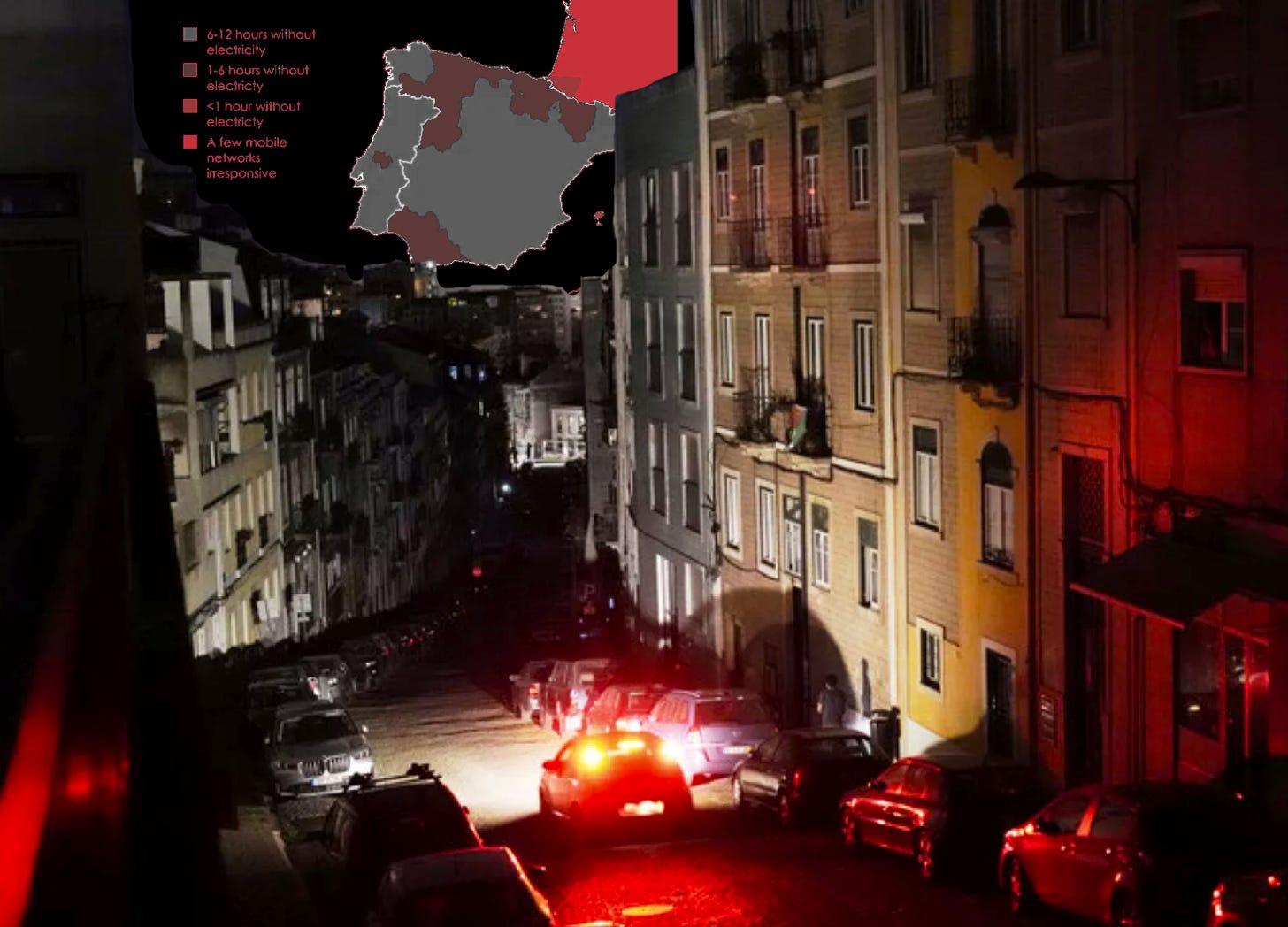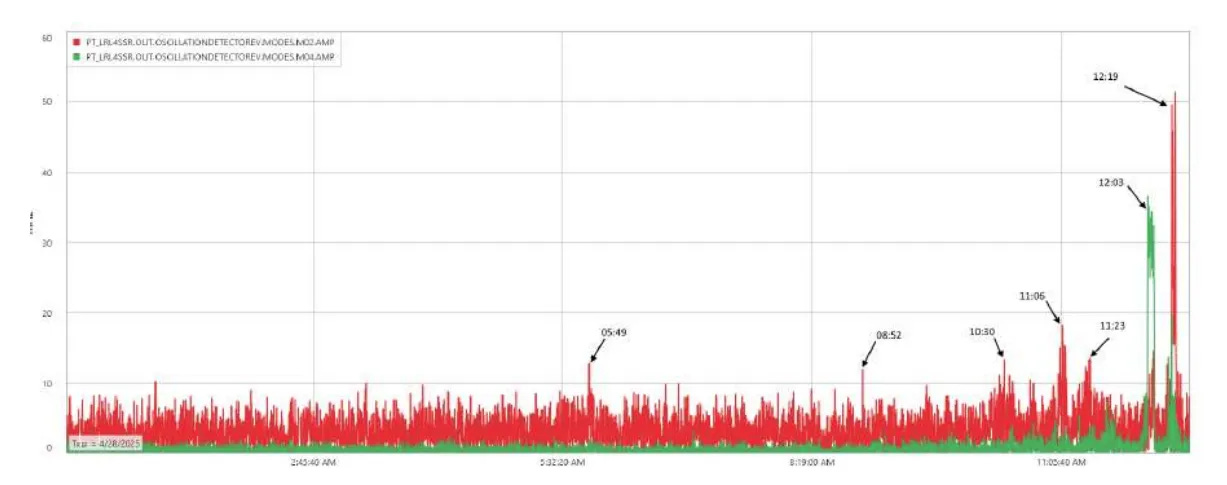The Spanish Grid Was "Fine" Three Minutes Before It Collapsed
TL;DR It was VARs, not intertia; undoing renewables won’t fix it
On 28 April 2025, at 12:33:30, the Iberian electric grid collapsed.
Immediately, the takes started flying—renewables did this; there wasn’t enough inertia; the grid operators didn’t use renewables right; this is why their ideology is bad and my ideology is good. But at the time, the correct answer to both “What happened?” and “How can we prevent this?” was “We don’t know yet.”
On 18 June 2025, we got real analysis from a pair of reports: one from Spanish transmission grid operator Red Eléctrica de España (REE), and one from the Spanish government. To this day, I have not found a graceful translation of the government report, so see attached the Claude translation I ran last month:
I remain disappointed by the immense alpha available in simply reading technical primary sources.
Let’s start with a timeline.
Special thanks to for sanity-checking the engineering and Spanish in this post.
What The Hell Happened?
The day started normally enough: it was a typical low-load “duck curve” day. Temperate weather reduced air conditioning load, and behind-the-meter solar generation zeroed out much of the remaining electric demand. In Spain’s wholesale electricity market, the day-ahead prices cleared at zero-to-negative between hour-ending1 11 AM and hour-ending 7 PM, because electric supply (driven by solar) completely washed out electric demand. This is normal.
What was not normal was the relative deficiency in voltage control resources. On 28 April, twelve resources were slated for dynamic voltage control—low, but workable. But the day before, one of those resources had a sudden outage, leaving only 4 nuclear, 1 coal, and 6 gas turbines online to manage voltage across Spain.
"Solo once en control de tensión. ¿No crees que vamos muy justos?"
"Sí, pero probablemente tire para hoy."
In the morning, the transmission system registered some voltage oscillations: mostly at 0.2 Hz, but a few at 0.6 Hz. The 0.2 Hz oscillations are known—they’re endemic to the European grid because of generators at the periphery (Spain, Turkey, the Southern Balkans) oscillating against the core. The 0.6 Hz oscillation was…new. In hindsight, it aligned with the output of a solar farm in Badajoz,2 but…photovoltaic (PV) resources typically do not oscillate like that. And even if they do, those oscillations shouldn’t reverberate into France and Germany, as this one did.
These oscillations ultimately aren’t crazy. The first few dissipated after a few minutes each, but system operators decided to nip them in the bud by connecting a few 400 kV circuits, which increases system damping. But then two new oscillations came: a big one at 12:03, and a bigger one at 12:19. These needed more serious measures:
Reducing (PV-driven) power export from Spain to France: first from 2,300 MW to 1,500 MW, then down to 1,000 MW.
Switching the Spain-France high-voltage DC (HVDC) interconnection from an “AC emulation” mode to a DC mode, mitigating the capacity for these oscillations to bounce around the entire European grid.
Closing a few more 400 kV circuits for local damping.
Asking Portuguese grid operators to reduce power flow from Spain to Portugal from 2,500 MW to 2,000 MW. The Portuguese said they would get to it by 1 PM, but were badgered into making it happen by 12:27 PM.
Calling up another conventional power plant to shore up dynamic voltage control. The quickest respondent said they could be online by 2 PM.
Things Are “Fine” at 12:30
Let’s take stock of the Spanish grid at 12:30:
The weird oscillations on the transmission network have all been damped.
Voltage through the system is a bit high (410-420 kV vs 400 kV nominal), but within operating limits.
AC frequency throughout the system is normal.
Further damping potential is low—the damping measures used are finite, and at this point, grid operators had already spent most of them.
Electric demand was pretty low, as expected from a mild Monday lunch hour.
The generation mix was 82% renewables.
There were eleven power plants dispatched for voltage control, as well as some pumped hydroelectric facilities that could chip in.
System inertia was at 2.3 seconds—above the 2 second guideline.
There was plenty of reserve—3,000 MW of pumped hydroelectric load that could shed in seconds, and 7,000 MW of reserve generation that could spin up in 15 minutes.
At this point, the electric grid was entirely within parameters. It was an eventful morning, but things looked okay. Exports were under control, oscillations were under control, and once that twelfth voltage control plant came online, grid operators could start unwinding their damping measures. By 2 PM, things would be fine—a stressful day, but not a crisis.
“¿Estás bien, cariño? Te veo cansado."
"Estoy bien. Solo ha sido un día de mucho estrés en el trabajo.”
Things Go Wrong at 12:32
At 12:32 PM, systemwide voltage starts to climb. The report isn’t clear on why, but it might be related to falling power exports from Spain to France. I don’t think the frequency oscillations from the morning caused this, but grid operators did reduce exports to damp those oscillations. And all over the Spanish system, generators start clicking offline.
The problem is something called reactive power, measured in volt-amperes reactive (VARs). As voltage in transmission lines climb up, those power lines act like giant capacitors, desynchronizing the oscillations of current and voltage. Engineers describe this as “generating VARs.” As reactive power builds up in the transmission system, voltage ticks upward. Generators—even generators that don’t do active voltage control—absorb those VARs, which keeps voltage in control.
But as generators click offline, that VAR absorption falls away, letting voltage climb higher and higher, leading to a feedback loop in which:
Voltage rises
→ Generators trip from over-voltage
→ The transmission network loses VAR absorption
→ Voltage rises more
It only takes a minute for voltage to reach critical levels. Then, at 12:33:18 PM, the system spirals out of control, posting terrifyingly high voltage numbers, until system frequency falls off a cliff, crashing the entire Iberian Peninsula into zero voltage at 12:33:30 PM.
A Lot of Things Look Weird in Hindsight
I can’t tell you what went wrong, or who’s at fault. I’m not a transmission engineer, and even these investigatory reports are incomplete. The Spanish government report particularly notes that the underlying data is messy and piecemeal—and a lot of the government report is redacted for the public, anyway.
But as I read these twin reports, I kept a log of “weirdnesses” in the whole fiasco:
Renewables in the Spanish system are required to hold a fixed power factor—balanced between generating and absorbing reactive power. Modern inverter-based renewable resources can adjust their power factor based on a set point, meaning they could be dispatched for dynamic voltage control. But they’re required not to. These reports suggest that there were plans to adjust this operating procedure, allowing renewables to participate in dynamic voltage control, but that didn’t happen in time.
On 28 April 2025, the following generation capacity was straight-up offline, not for economic reasons but for repair, inspection, maintenance, or nuclear fuel recharging:
50% of all coal generation
30% of all combined-cycle gas generation
43% of all nuclear generation
42% of all pumped hydroelectric storage
The fastest dynamic voltage control resource that grid operators could find needed 90 minutes to fire up. And that power plant was already hot. Aeroderivative3 power plants in the 10-50MW range can fire up from cold in ten minutes. Can none of those do voltage control?
A 0.6 Hz oscillation from a single solar farm in the far west of Spain echoed into the core of the European grid.
At 12:19 PM, exports from Spain to France were set to 1,000 MW. But by 12:32 PM, exports were back up to 1,500 MW. And one line exported power without interruption right up to zero voltage.
The 11 power plants tapped to provide dynamic voltage control…mostly did not. A few actually generated reactive power, meaning they worsened the problem they were dispatched to mitigate. The reports are reluctant to tattle, but it seems like these deficiencies were not new.
Prior to the blackout, Spain had plans to decommission all nuclear power plants in the country—four by 2030, the last three by 2035. One plant, the ailing Almaraz plant, is slated for decommissioning in 2027.
Many renewable resources—particular the lower-output ones—also didn’t meet their reactive power requirements.
A bunch of generators tripped prematurely—they are supposed to survive 440 kV over-voltages for 60 minutes, but many did not.
One of the first generators to trip did so because of an over-voltage downstream of the core transmission system—meaning the initial sparks of the cascade failure started from over-voltages that central grid operators literally could not see.
In fact, the reports suggest (but don’t have enough hard data to confirm) that the first few generators to trip offline are distributed renewables—small generations out of easy reach of transmission grid operators.
More inertia would not have helped.
Emergency demand shedding might have made it worse.
The Spanish electric grid was within normal operating conditions three minutes before it collapsed.
No One Thought This Would Happen
This cascade electric failure clearly caught everyone off-guard. As late as 12:15 PM, Portuguese grid operators were back-talking about export interfaces, apparently asking “Can’t this wait 45 minutes?” And they probably thought it could.
And for all I can tell, the oscillation damping didn’t even cause the cascade failure—maybe cutting exports to damp those oscillations led to runaway over-voltage? But then why did some generators trip early? Why couldn’t existing voltage control measures catch that? Did no one think to check if the voltage regulation measures worked? The answer, clearly, is no. Otherwise, someone would have caught the deficiencies earlier.
And even if Spanish grid operators could catch those deficiencies, what could they have done on short notice? The transmission network went from systems-green to zero-voltage in ninety seconds. Aeroderivative power plants can’t move fast enough to catch that. For that matter, no human-in-the-loop (HITL) operating procedure could move fast enough.
The 28 April Iberian Blackout isn’t merely a story of “renewables bad” or “Red Eléctrica dumb”—this voltage runaway is a new problem that overwhelmed existing operating procedures, market structures, physical infrastructure, and technical staff. You wouldn’t have seen this coming, either.
But now we have seen it. We now know that an electric grid the size of, say, the ERCOT system can go from normal conditions to total blackout in ninety seconds. We now know that dynamic voltage control needs to catch over-voltage conditions in less than fifteen seconds. We have yet again been reminded that we have not reckoned with the promise and the danger of distributed, intermittent, inverter-based electric resources.
And if the internet discourse is any indication, we’re still not ready to have that conversation.
This post and the information presented are intended for informational purposes only. The views expressed herein are the author’s alone and do not reflect those of their current or previous employers or any elected officials. The author makes no recommendations toward any electric utility, regulatory body, or other organization. While certain information contained herein has been obtained from sources believed to be reliable, the author has not independently verified this information, and its accuracy and completeness cannot be guaranteed. Accordingly, no representation or warranty, express or implied, is made as to, and no reliance should be placed on, the fairness, accuracy, timeliness or completeness of this information. The author assumes no liability for this information and no obligation to update the information or analysis contained herein in the future.
Hour Ending (HE) 11 is 10:00 AM to 11 AM.
Probably the Núñez de Balboa plant
Literally, power plants based on jet engines





A very perceptive piece of writing. So many commentators have drawn conclusions that the problem was x or y. I like the open explanation that this was something new.